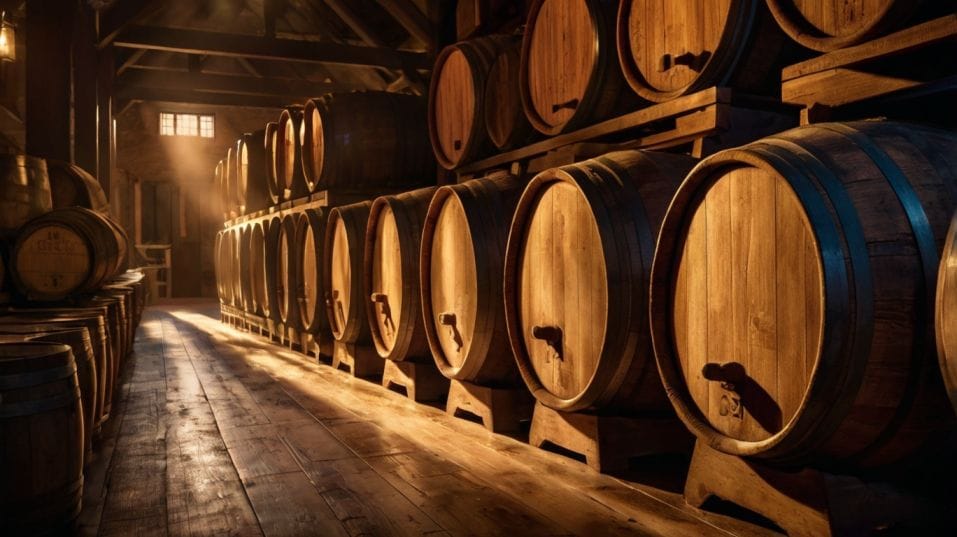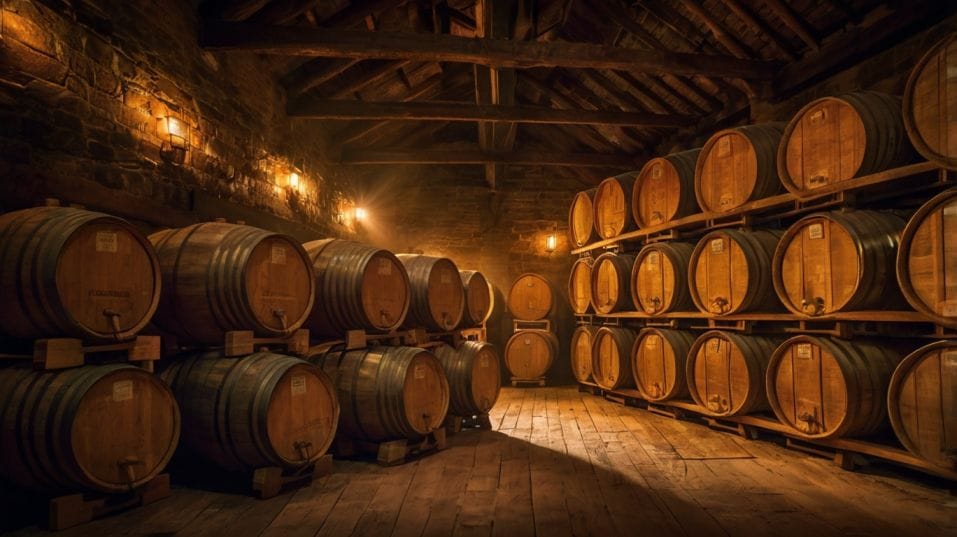Why Your Whiskey Tastes Like Vanilla: A Barrel Story
Why does whiskey taste like vanilla? Discover how barrels shape flavor—and how vanilla hints at the secrets inside every bottle.

Ever wonder why your whiskey tastes like vanilla—even when no flavor’s been added? That sweet note isn't a trick. It's chemistry. Whiskey earns its flavor inside the barrel, not the bottle.
And if you're just getting serious about sipping, vanilla is your clue: a signal that points to fire, wood, and time at work. Learn what’s behind it, and you'll never taste whiskey the same way again.
Whiskey Isn’t Born. It’s Built in a Barrel.
New make spirit—the raw distillate straight from the still—is clear, fiery, and sharp. You can think of it as the unseasoned base. It’s got potential, but no polish.
That golden amber color you associate with whiskey? That rich aroma? Those deep vanilla, caramel, and spice notes? None of that exists in the new make. It all comes from the barrel.
More than 50% of a whiskey’s final flavor comes from its time in wood. That’s not an opinion—it’s the general consensus among distillers, tasters, and researchers.
The barrel doesn’t just “hold” the whiskey while it ages. It transforms it. And here’s where vanilla enters the picture.

The Vanilla Connection: It’s All in the Chemistry
American white oak—Quercus alba—is the wood of choice for most whiskey barrels, especially in bourbon production. What makes this wood so important isn’t just durability or tradition. It’s what’s inside.
Oak contains a compound called lignin, which is a key structural component of plant cell walls.
When the inside of a barrel is charred—literally set on fire—lignin breaks down into vanillin, the same aromatic compound that gives vanilla beans their signature smell and flavor.
The charred layer becomes a rich surface of carbon and broken-down wood compounds.
Over years, whiskey soaks into the wood during warm seasons, then recedes during cooler ones, absorbing vanillin and other flavor compounds like lactones (which contribute coconut and buttery notes), tannins (which add structure and dryness), and hemicellulose (which breaks down into sugars and toasty flavors).
This is where your whiskey picks up those dessert-like qualities: vanilla custard, crème brûlée, toasted marshmallow.
All of it comes from a chemical interaction between spirit and scorched oak. No added flavors. No tricks. Just time and chemistry.
Not All Charring Is Equal
Barrel char isn’t just a cosmetic feature—it’s one of the most critical decisions a whiskey maker can make. It affects not just flavor, but extraction speed, mouthfeel, and how the spirit evolves over time.
If you want to understand why some whiskeys hit harder with sweet, smoky vanilla while others lean dry and spicy, you need to start with the fire.
What “Char Level” Really Means
The “char level” of a barrel refers to how long it’s exposed to open flame before it's filled with whiskey.
There’s no universal standard, but most barrels used for bourbon are charred between 15 to 60 seconds, on what’s often called a level 1 through 4 scale.
- Lighter char (Level 1–2): Preserves more tannins and woodier notes, less sweetness.
- Medium to heavy char (Level 3–4): Unlocks more vanillin, caramelization, and sweetness.
- “Alligator” char: At this depth, the interior of the barrel develops a crackled, scale-like texture—ideal for intense flavor extraction.
The deeper the char, the thicker the caramelized layer of wood sugars and vanillin your whiskey gets to work with. This isn’t subtle.
Two barrels of the same size, aged for the same amount of time, can produce radically different whiskey if one was lightly charred and the other was scorched.
So if a whiskey hits you with bold vanilla right away, chances are it was aged in a heavier char barrel.
Time + Temperature = Flavor
Think of the barrel as more than a container. It’s a living flavor factory. As temperatures rise and fall—especially in warehouse environments without climate control—whiskey expands into and contracts out of the wood.
This movement allows it to interact with different layers of the stave, extracting flavor and color as it moves.
Warm climates speed up this cycle. That’s why whiskeys aged in Kentucky, Tennessee, or Texas can taste more mature in fewer years than their Scottish or Irish counterparts.
More heat means more wood interaction, more vanillin extraction, and more intense oak-driven flavor in a shorter time.
But this isn’t just about speed. Fast aging doesn’t always mean better flavor. There’s a balance.
Over-extraction can lead to bitterness, harsh woodiness, or flat sweetness with no complexity. Great whiskey makers know how to let the barrel do its work—without rushing or overdoing it.
Wood Has a Terroir of Its Own
When people talk about terroir in wine, they mean soil, climate, and geography. Whiskey has its own version of that—and it starts with the trees.
The oak used to build barrels isn’t just raw material; it’s a source of flavor, structure, and personality. Where and how that oak grows makes a difference you can actually taste.
Grain Tightness and Regional Oak
The barrel’s impact doesn’t stop at char and climate. The wood itself matters. American oak is the standard in bourbon. It’s dense but porous, loaded with vanillin, and grows relatively quickly. But not all American oak is equal.
The tightness of the grain—how closely packed the growth rings are—affects how the whiskey penetrates the wood.
- Tight grain oak (from slow-growing trees): Releases flavors more gradually, often producing more subtle and refined notes over time.
- Loose grain oak (from faster-growing trees): Gives up flavors faster, often leading to bold vanilla and coconut early on.
Some distillers even select barrels based on the forest or region the trees came from—Ozark oak vs. Appalachian oak, for instance—because the soil and climate affect how those trees grow, just like grapevines in wine.
These small differences add up over years in a warehouse.
Toasting Before Charring
Even the toasting step before charring—gently heating the wood to break down lignin and hemicellulose—has a massive impact.
Toasted barrels (common in some craft and wine-finished whiskeys) tend to bring forward sweeter, rounder vanilla notes without as much bitter char. A toasty vanilla note versus a burnt marshmallow one? That’s toasting vs. charring.
How to Taste Vanilla With More Intention
When you sip and sense vanilla, don’t just clock it and move on. Focus in.
- Is it sharp and clean, like extract?
- Soft and creamy, like pudding?
- Burnt-sweet, like caramel or toasted sugar?
These differences are clues. They tell you about barrel treatment, aging time, and even the temperature swings the whiskey endured.
With experience, you’ll start to predict what a whiskey might taste like based on its aging environment or mashbill—even before you taste it.
And when you get it right, it’s like solving a flavor puzzle. That’s the difference between drinking and tasting.
Final Thoughts
That vanilla note in your whiskey is your first clue—and maybe your best teacher. It’s not just sweet. It’s structural. It signals the work of oak, fire, time, and climate.
Learn to read that signal, and you’ll start to see whiskey less as a mystery and more as a map.
There’s no need to memorize barrel charts or collect rare bottles. Just pay closer attention to what’s already in your glass. Follow the vanilla. Chase it through layers of oak, spice, toast, and char.
Then taste again. Collect with purpose. Build a palate that knows how to decode a barrel’s story—sip by sip.
Start tonight. Pour a whiskey you’ve had before, and taste it again like it’s new. Vanilla’s in there. Now you know why.




